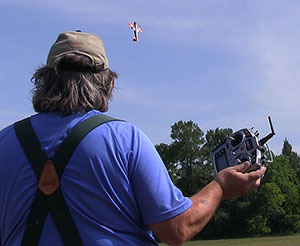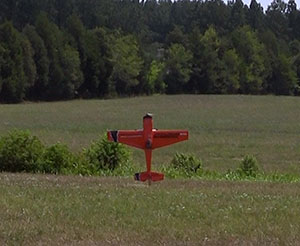



This is the little Hero-maker. It made me
remarkably better on the sticks in about
10 minutes..
Text by Tom Hintz
Video by Gihad Jawhar
Posted – 7-14-2015
I hadn’t even taken the Bavarian Demon Cortex to the flying field and I had already been called a “cheater” by a fellow club member who at the same time accidentally relieved me of test flying his planes…… Call me what you want, I am having too good of a good time to care. The Bavarian Demon Cortex is helping me learn to do things that I couldn’t before, I can safely fly in more wind and my plane doesn’t need repair so I am a happy user/cheater.
I put the Bavarian Demon Cortex in my Aeroworks 50cc Edge 540 and changed nothing else about the plane. The CG is right where the factory calls for it (using their CG Buddy) and the overall weight may have increased by around 20-25 grams. None of the control surfaces were adjusted, throws remain as before the Bavarian Demon Cortex was installed. I have zeroed out all of the dual rates (I never used them for this plane anyway) in the radio and set expo to 30%.
For the first flights I had the Bavarian Demon Cortex Home bank gain set to 25 and the Hold bank to 40. This was one of the only flying days I can remember that I was actually hoping for some wind to better test the wind fighting capabilities of this gyro. I have to be careful what I wish for as the winds kicked up and felt like well over 25 mph in gusts throughout day one of Bavarian Demon Cortex testing.

Yeah, look close, it's hovering "on its own"
sort of. It doesn't just stay there forever
but it is cool while it does.
One of the first lessons with the Bavarian Demon Cortex was that the gains are going to be a constant tuning tool. I suspect the gain settings will be very different between a windy day and one with light winds. I took off for the first flight with the Bavarian Demon Cortex shut off and once I got some altitude put it in the Home mode. Immediately I could see the wings begin a slight oscillation when I turned the Aeroworks 50cc Edge 540 into the wind at full throttle.
We have to remember that the wind imitates air speed and adds to the pressures on the control surfaces. Every gyro I have tried was impacted by the wind in that they would develop oscillations when the gains were set too high. That also happens with the Bavarian Demon Cortex but somewhere between the high-end sensors and superior programming controlling this oscillation is easy. I landed during the Bavarian Demon Cortex maiden flight, reduced the bank 1 gain by 5 and could see a big improvement in the air. Later on the first day I dropped the bank 1 gain another 5 points to 15 and that mode was fine the rest of the day. Day two of testing had less wind and I was able to tweak the gains up about 5 points on both banks.
The Hold mode (bank 2) reaction to gusty winds was more pronounced because of the large surface movements made by the Bavarian Demon Cortex. Not surprisingly the oscillations in gusty winds were dramatic if you enter that mode with more than high alpha type speeds. I could reduce the oscillations by dropping the Hold mode gain from 40 to 30. At that setting I still had to be sure the plane was slowed to near harrier speeds before flipping the switch into Hold mode when headed into the wind or the Bavarian Demon Cortex would oscillate some. Here also on day two in lighter winds I was able to jack the Hold gain up to 35 and would see oscillations only if I had too much speed.
Needing gain changes in heavy winds is not a deficiency in the Bavarian Demon Cortex but rather testament to how sensitive its high-end sensors are. I think we will need to tweak the gains to suit the wind conditions of the day. Since we make these changes in the transmitter this is a quick simple change that can be made on the flight line.
On day one with the gains backed down I made landing approaches with the Bavarian Demon Cortex turned off and then with it in Home mode and the difference was dramatic. The wings were far more stable and my primary jobs during approaches were applying elevator to control sink and to vary power as needed to maintain a little ground speed into the gusty winds. I wound up having to do a story on

repairing the rudder after I got too brave
and backed it into the ground. It flew away
though.
The Bavarian Demon Cortex works hard at stabilizing the plane but it does not fly it. On all of the other landing attempts with the Bavarian Demon Cortex engaged I managed the airspeed and despite the wind, landing was surprisingly easy.
There are misconceptions that the Bavarian Demon Cortex will fly knife edge hands-off and that it will do slow rolls on a rope with no help from the pilot. The reality is that the Bavarian Demon Cortex makes all of these types of maneuvers easier but you still have to use the control sticks correctly.
One of the more popular claims about the Bavarian Demon Cortex is that it will hover a plane all on its own. I found that it can and it can’t. If you pull the plane up into a perfectly vertical hover the Bavarian Demon Cortex will hold that for quite a while. However, if you pull it up with the fuselage at an angle the Bavarian Demon Cortex will work to maintain that angle and it will slowly tip over. You have to make small corrections to the fuselage angle to help the Bavarian Demon Cortex maintain the hover.
On day one in the heavy winds my attempts at hovering in Hold mode (bank 2) showed that while the Bavarian Demon Cortex can hover a plane it will not hold a position. It looks a little odd to have the Bavarian Demon Cortex holding the plane surprisingly steady vertically while the wind moves it across the sky horizontally.
Also, since the Bavarian Demon Cortex Holds the roll axis so well, a hover does not produce torque rolls. Usually when you enter the hover in the Hold mode you can see the ailerons deflect to counter the torque effect of the motor on the airframe. I was able to induce a “torque roll” artificially by adding a little aileron to the hover.
Bavarian Demon Cortex literature warns of increased power usage because of the many small corrections this gyro is making. After my first day of flying the Bavarian Demon Cortex (five 10-minute flights) I saw roughly a 20% increase in the milliamps needed to fully recharge my packs. I use a pair of 5000mAh packs so I was not in danger of running out of power but this increased power usage is a reality and warrants checking to learn how your on board power supply handles the load. We should be checking the remaining battery capacity at the field anyway, with the Bavarian Demon Cortex we should do it a little sooner on flight day until we understand the discharge rate for that plane.
It occurs to me that the adjust-ability of the Bavarian Demon Cortex combined with its accuracy means that we can use it as a teaching tool. Let the Bavarian Demon Cortex do more of the work initially until we get proficient at a harrier, hover, landings or whatever and then begin backing the gains down to put more of the work load on the pilot. Using a trainer cord or dual rates are accepted ways to improve piloting skills and I see no reason why we should not accept the use of the technology the Bavarian Demon Cortex offers for the same purpose.
The Bavarian Demon Cortex will not take over the controls to prevent a crash if the pilot does something very wrong. However it will make a plane easier to fly, particularly in the wind and will give a pilot a more stable platform that makes perfecting flying skills safer for the plane which saves real money. The ability to limit the effects of wind also increases the amount of flying time which increases the pace of learning as well.
I am sure there will be some who consider using the Bavarian Demon Cortex to be cheating and I doubt anything that can be said here will convince them otherwise. If history teaches us anything it should suggest that using a reliable fixed wing gyro will become as accepted as using the modern flybarless systems on helicopters.
A friend of mine pointed out that the responsibilities of work and family limit the time he can spend at the flying field. He feels that the Bavarian Demon Cortex makes the time he does spend flying more enjoyable and helps prevent damage to his planes. There is no legitimate argument to make his logic wrong. We put a lot of money in our planes and adding a Bavarian Demon Cortex is simply a form of insurance that can help us enjoy flying a little more.
The Bavarian Demon Cortex is obviously a well-made, thoughtfully designed gyro that works at least as well as the manufacturers claims. I think this is one of those increasingly rare times when a product just might exceed the hype. It is not an auto pilot and there is no implied magic. The Bavarian Demon Cortex is simply a very good aircraft stabilization tool that can make more flying more fun for more pilots. Whether used as a teaching aid or to simply help deal with winds that might have kept your planes in the car, the Bavarian Demon Cortex is effective and reliable.
I paid $289.00 (7-1-2015) for my Bavarian Demon Cortex and while that is a bunch for my budget I am confident it will save me far more in repair money as I learn new things. Like many flying fields ours has areas of turbulence when landing on windy days and the Bavarian Demon Cortex helps me negotiate those landings easier which gives me substantially more flying time.
If you are looking for a device to make you an instant 3D pilot check the local magic shop, the Bavarian Demon Cortex isn’t for you. If you seek a device that will make flying more enjoyable in more conditions you need to check out the Bavarian Demon Cortex. I think this is a worthy investment that will actually save many of us repair money in the process.
Visit the Bavarian Demon Cortex web page – Click Here
Have a comment on this review? –Email Me!